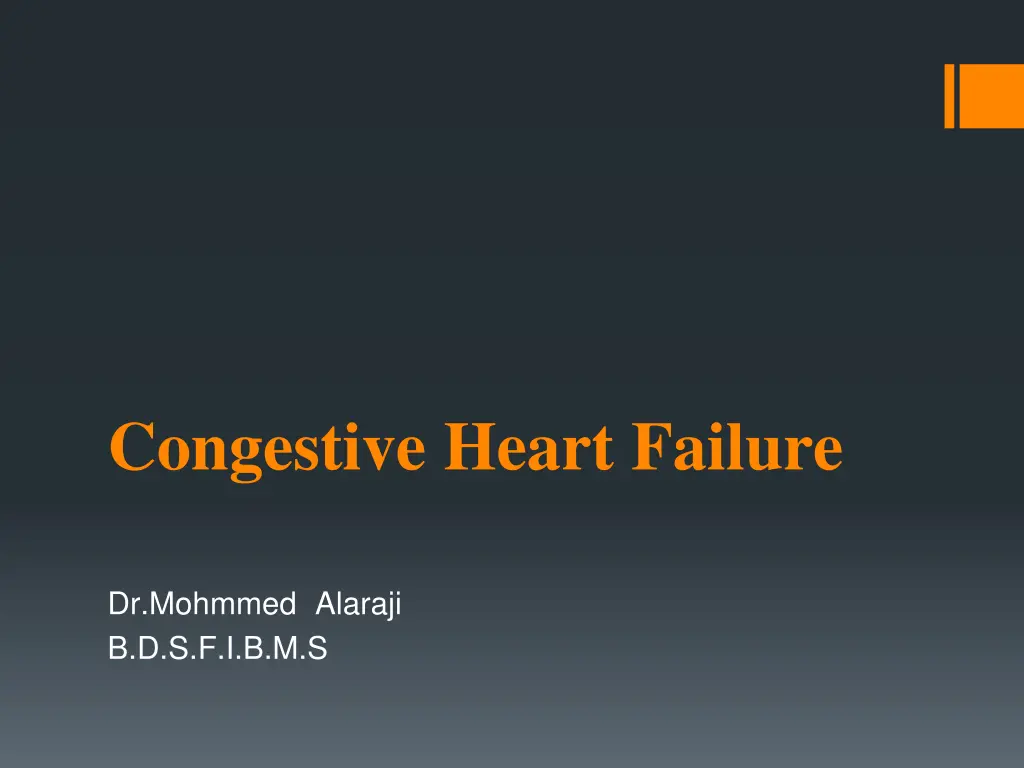
Understanding Congestive Heart Failure
Learn about congestive heart failure, its causes, symptoms, and signs. Discover how it is diagnosed and find out about dental management for patients with heart failure.
Download Presentation

Please find below an Image/Link to download the presentation.
The content on the website is provided AS IS for your information and personal use only. It may not be sold, licensed, or shared on other websites without obtaining consent from the author. If you encounter any issues during the download, it is possible that the publisher has removed the file from their server.
You are allowed to download the files provided on this website for personal or commercial use, subject to the condition that they are used lawfully. All files are the property of their respective owners.
The content on the website is provided AS IS for your information and personal use only. It may not be sold, licensed, or shared on other websites without obtaining consent from the author.
E N D
Presentation Transcript
Congestive Heart Failure Dr.Mohmmed Alaraji B.D.S.F.I.B.M.S
Congestive heart failure is defined as the inability of the myocardium to pump enough blood to satisfy the needs of the body, so that the lungs and/or the systemic circulatory system are congested.
Most Common Causes of Heart Failure Coronary heart disease Hypertension Cardiomyopathy Valvular heart disease Infective endocarditis Congenital heart disease Endocrine disease
Symptoms of Heart Failure 1. Dyspnea (perceived shortness of breath) 2. Fatigue and weakness 3. Acute pulmonary edema (cough or progressive dyspnea) 4. Exercise intolerance (inability to climb a flight of stairs) 5. Dependent edema (swelling of feet and ankles after standing or walking) 6. Report of weight gain or increased abdominal girth (fluid accumulation; ascites) 7. Anorexia, nausea, vomiting, constipation (bowel edema)
Signs of Heart Failure A. Rapid, shallow breathing B. Heart murmur C. Distended neck veins D. Large, tender liver E. Jaundice F. Peripheral edema G. Ascites H. Cyanosis I. Weight gain
Diagnosis Heart failure is diagnosed clinically and by: chest radiography (cardiomegaly). ECG and biochemistry. Echocardiography.
Dental Management of the Patient with Heart Failure Evaluate patient for history, signs, or symptoms of heart failure (HF). For patients with symptoms of untreated or uncontrolled HF, defer elective dental care and refer to physician. For patients diagnosed and treated for HF: Confirm status with patient or physician. Identify underlying cardiovascular disease (i.e., coronary artery disease, hypertension,cardiomyopathy, and manage appropriately. For patients taking digitalis, avoid epinephrine; if considered essential, use cautiously (maximum 0.036 mg epinephrine ) Schedule short, stress-free appointments. Watch for orthostatic hypotension, make position or chair changes slowly, and assist patient into and out of chair. Avoid the use of nonsteroidal antiinfl amatory drugs (NSAIDs). Nitrous oxide/oxygen sedation may be used with a minimum of 30% oxygen.
Cardiac arrhythmia, which refers to any variation in the normal heartbeat, includes disturbances of rhythm, rate, or the conduction pattern of the heart.
Signs and Symptoms of Cardiac Arrhythmias SIGNS Slow heart rate (<60 beats/min) Fast heart rate (>100 beats/min) Irregular rhythm SYMPTOMS Palpitations Fatigue Dizziness Syncope Angina Shortness of breath Peripheral edema
Dental Management Recommendations for Patients With Cardiac Arrhythmias STRESS AND ANXIETY REDUCTION Establish good rapport Schedule short, morning appointments Ensure comfortable chair position Provide preoperative sedation (short-acting benzodiazepine night before and/or 1 hour before appointment) Administer intraoperative sedation (nitrous oxide/oxygen) Ensure profound local anesthesia Provide adequate postoperative analgesia
VASOCONSTRICTORS Epinephrine-containing local anesthetic can be used with minimal risk if the dose is limited to 0.036 mg epinephrine (2 capsules containing 1 : 100,000 concentration). Higher doses may be tolerated, but the risk of complications increases with dose.
FOR PATIENTS WITH PACEMAKERS Antibiotic prophylaxis to prevent bacterial endocarditis is not recommended. Avoid the use of electrosurgery and ultrasonic scalers.
FOR PATIENTS TAKING DIGOXIN Watch for signs or symptoms of toxicity (e.g., hypersalivation) Avoid epinephrine .
FOR THE HIGH-RISK PATIENT WHO REQUIRES URGENT CARE, CONSIDER TREATING IN SPECIAL CARE CLINIC OR HOSPITAL Consult with physician Provide limited care only for pain control, treatment of acute infection, or control of bleeding Intravenous line Sedation Electrocardiogram (ECG) monitoring Pulse oximeter Blood pressure monitoring Avoid or limit epinephrine






















